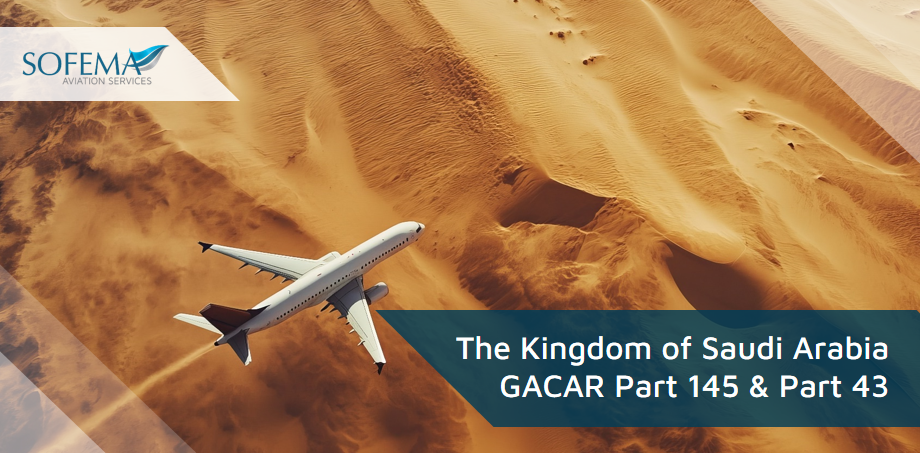Sofema Aviation Services (SAS) www.sassofia.com reviews the key events related to the Kingdom of Saudi Arabia GACAR Part 145 & Part 43
The evolution of GACAR regulations, particularly GACAR 43 and 145, has been pivotal in ensuring the safety and efficiency of aviation operations in Saudi Arabia. The regulatory framework has provided clear guidelines for maintenance and repair stations, aligning the Kingdom with international aviation standards while addressing its unique operational context
1960s-1970s: Adoption of U.S. FAA Regulations
As the Kingdom’s civil aviation sector grew, Saudi Arabia initially adopted aviation safety regulations from the United States Federal Aviation Administration (FAA). This decision was a strategic move to align with internationally recognized safety standards as the country’s aviation infrastructure and activity began to expand.
1990s: Establishment of GACA
The General Authority of Civil Aviation (GACA) was formally established, marking a pivotal moment in Saudi Arabia’s civil aviation development. GACA became responsible for regulating the aviation sector, including safety, airworthiness, and airport operations. The aviation regulatory framework still relied heavily on FAA regulations but began to evolve with more specific adaptations for Saudi Arabia.
2000s: Early Steps Towards Independent Regulation
GACA started working on the development of a more autonomous set of regulations, incorporating international safety standards while addressing the unique needs of Saudi Arabia’s aviation environment.
2010-2015: Introduction of GACAR
The General Authority of Civil Aviation Regulations (GACAR) was officially introduced, establishing a comprehensive framework that replaced many of the previously adopted U.S. regulations. This marked a significant step towards independent aviation regulation in the Kingdom, with GACAR addressing specific regional and operational needs.
2015: Publication of GACAR Part 145 and Part 43
GACAR Part 145: This part specifically governs repair stations, detailing certification requirements, safety standards, and operational rules for facilities performing maintenance on Saudi-registered aircraft. The introduction of GACAR Part 145 provided a structured approach to repair station operations, ensuring compliance with both national and international safety standards.
GACAR Part 43: This part defines the rules governing maintenance, preventive maintenance, rebuilding, and alteration of aircraft. GACAR Part 43 is essential for mechanics and repair facilities, establishing who can work on Saudi-registered aircraft, how maintenance is to be performed, and the standards that must be met to ensure airworthiness.
2016-Present: Refinement and Updates
Since their publication, GACAR Parts 43 and 145 have undergone updates and refinements to stay aligned with international best practices while continuing to meet the growing and evolving needs of the Saudi aviation industry. These updates have ensured that the regulations remain relevant in the context of technological advancements and the expanding aviation market in the region.
- Version Updates: Both GACAR Part 43 and Part 145 have been incrementally updated to Version 4.0. These versions introduced more detailed guidelines on maintenance procedures, personnel qualifications, and safety systems. For example, the 2020 update for GACAR Part 43 introduced refinements in recordkeeping for major repairs and alterations, including the addition of Appendix B for recording major repairs and alterations (GACAR Part 26).
Abbreviated Summary of Key Focus Areas of GACAR Part 26
- Aging Airplane Safety: Requires assessments and actions to address risks related to widespread fatigue damage (WFD) and ensure continued structural integrity as aircraft accumulate flight cycles and hours.
- Fuel Tank Flammability: Mandates design changes to reduce flammability risks in fuel tank systems, especially in older aircraft, enhancing long-term operational safety.
- Damage Tolerance: Ensures that all repairs and alterations maintain or improve an aircraft’s damage tolerance, which is critical for ageing aircraft structures.
- Electrical Wiring Interconnection Systems (EWIS): Requires the development of maintenance programs to ensure safe and reliable functioning of electrical wiring systems over time.
Next Steps
Follow this link to our Library to find & download related documents for Free.
Sofema Aviation Services www.sassofia.com provides regulatory training that is compliant with GACAR Parts Parts 43 and 145. Please see the following link or email team@sassofia.com.
Tags:
aircraft repairs, Saudi GACA, GACAR Part145, Part43 Standards, GACAR Regulations, Saudi Aviation, Aircraft Repair Stations, Maintenance Safety, Aviation Compliance, aviation standards, EASA Part 145 Compliance Function, Aircraft Maintenance, Civil Aviation, Aviation Regulations, SAS blogs, GACAR Part 43, Airworthiness, Sofema Aviation Services, MRO, Aviation Training, aviation safety




